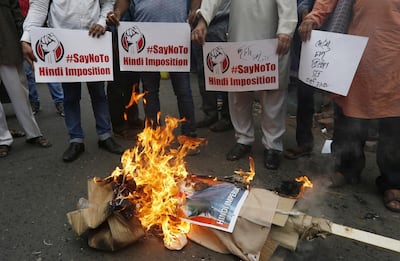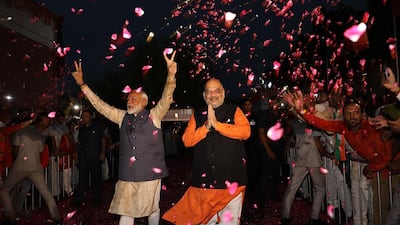Standing before a packed stadium in Houston, Indian Prime Minister Narendra Modi asked his audience a rhetorical question: how are things in India? Before the 50,000 Indian-Americans who gathered to greet him on his US tour last week, he answered in Hindi: “All is well” – then repeated the answer in Punjabi, Gujarati, Bengali and four other languages.
The point he was making was more significant than the message, but just in case it passed people by, Mr Modi later made it explicit. “Our various languages are an important identity of our liberal and democratic society,” he said. “For centuries, our nation has been moving forward with dozens of languages and hundreds of dialects.”
It felt like firefighting: an exertion to battle the heat that Mr Modi’s government has been facing this month after Amit Shah, his home minister, suggested it was “extremely necessary” for Hindi to project India’s identity in the world.
“Today, if any one language can do the job of holding the country together with the thread of unity, it is indeed the most widely spoken, Hindi,” Mr Shah tweeted a fortnight ago.
His remarks have ignited a blaze of controversy and echoes previous clashes over moves to impose Hindi upon a nation with thousands of languages and dialects. And it has raised the fear that the Bharatiya Janata Party (BJP) will try to do so again.
With remarkable wisdom, BR Ambedkar and his fellow architects of India’s constitution avoided designating a national language when they drew up the document in 1949. Instead, they named two official languages in which the federal government could conduct its business: English and Hindi. India’s states, they added, could determine their own official languages.
In a country where 43 per cent of people use Hindi as their mother tongue, this was a reasonable compromise.
Yet even as provinces were being formed along linguistic lines, this arrangement nearly unravelled in the mid-1960s. The Indian government moved to discard English altogether as an official language. Among the implications of this was that civil service examinations would be conducted in Hindi.
This set off violent protests. In Tamil Nadu and other parts of south India, where the languages belong to a different linguistic family altogether, riots ensued. The government backed down, not only retaining English but conducting public service examinations in regional languages as well.
There have been other protests since then, although none quite as violent. Most recently, in 2014, the newly elected BJP administration instructed federal government employees to use Hindi preferentially over English on their social media accounts – an instruction that was rolled back after Tamil Nadu complained.
As a result of this opposition, India has largely maintained its linguistic diversity, even as its neighbours have struggled with theirs. An undivided Pakistan's attempt to impose Urdu upon its Bengali-speaking eastern half played a role in the formation of Bangladesh in 1971. In Sri Lanka, a civil war raged from 1983 to 2009 after the minority Tamils saw that the majority Sinhalese people and their culture, including their language, were being accorded preferential treatment.
But Mr Modi’s BJP, with its large parliamentary majority and its role in governing 18 out of 29 Indian states directly or in coalition, could conceivably upset this fine balance.
Ideologically, the spread of Hindi aligns neatly with the BJP’s interests. Its version of Hindu nationalism is rooted deeply in the culture of the north Indian Hindi-speaking heartland. The south and the east have traditionally proven less susceptible to the party’s religious rhetoric but recent electoral results in these regions show a turn is under way.
The BJP government also rules India with the strongest federal hand seen in decades. In its revocation of Jammu and Kashmir's statehood and in its plans to formulate a pan-Indian National Register of Citizens, modelled on its project in Assam, we see clear ambitions to define a narrow, rigid idea of Indian identity – one that poses risks for minorities of every stripe.
Further, as India's economy continues to be challenged under Mr Modi's watch, there is more incentive for the BJP to do what it does so well: misdirect the public by talking up cultural values and nationalism in a bid to distract voters from real issues.
Its intentions are clear. Last year Mr Modi’s then finance minister Arun Jaitley broke with tradition and presented sections of his budget in Hindi. Until then, budgets had been presented only in English – a language understood, admittedly, by a smaller section of the populace but still one that belongs to all Indians.
Even in regional airports, which are administered by the federal government, announcements are made in Hindi before being made in the local language. Federal agencies such as the telecom giant BSNL rarely field English speakers to respond to customers. Only an uproar convinced the federal highways authority to stop replacing English with Hindi in highway markers in Tamil Nadu.

If the BJP decides to press ahead with its effort to make Hindi the country’s pre-eminent language, it might feel encouraged by change on the ground of a more organic kind.
Half a century after the anti-Hindi riots, India is a visibly different country. Domestic mobility and migration have increased. In Bengaluru – a city whose auto rickshaw drivers spoke almost nothing but Kannada three decades ago – Hindi now works as a lingua franca in many situations. With the explosion of cable TV and social media, the reach of Bollywood has expanded.
But to conflate these voluntary shifts with a readiness for the imposition of Hindi would be a mistake.
The anger that greeted Mr Shah’s statement showed that linguistic identity is still fiercely protected and remains a provocative issue. Even with its political dominance, the BJP will find it difficult to force Hindi on other parts of the nation without meeting widespread agitation.
What is far more likely is that the government will attempt to smuggle Hindi in through the back door, switching it for English or making its use non-negotiable in an increasing number of situations. For anyone who prizes India’s linguistic diversity, this is the campaign they must watch out for.

